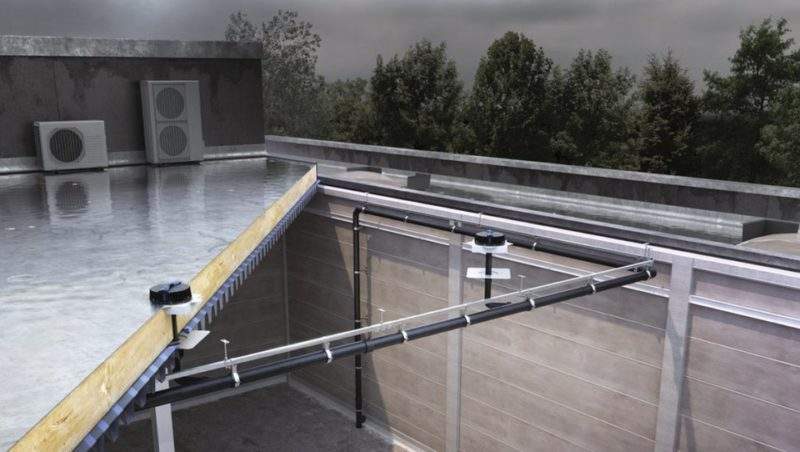
The construction industry plays an essential role in Australia’s economy. In a growing market, siphonic roof drainage systems are transforming from a niche product to the default system for buildings with large roof areas. In fact, Australia is becoming a leader in siphonic roof drainage having conducted the only research worldwide in the past ten years.
Roofs may be constructed with or without gutters. There are two categories of gutters: eaves and box gutters. Eaves gutters form the outer perimeter of the roof and their shape allows excess water in high rainfall events to safely overflow over the outside lip of the gutter. Box gutters sit within the façade or structure of the building.
Early in 2017, proposed changes to AS 3500.3: 2015, the Australian Plumbing and Drainage Standard for Storm Water, were released for public comment. These changes would include siphonic roof drainage within the Australian construction code for the first time. An area of concern for Geberit was the reference to parameters, which were somewhat contentious among designers, especially the numerous references to priming time and gutter design without any detail on a calculation method.
Geberit undertook further research around priming time and gutter design to influence and develop the debate in the industry. The following paragraphs compare conventional and siphonic roof drainage systems and analyse the problems with solely focusing on priming time.
Conventional Drainage Systems
A typical arrangement involves regularly spaced individual down-pipes at low points in a gutter, which carry the water through a network of underground pipes to the public stormwater infrastructure. Conventional roof drainage operates at atmospheric pressure. The flow-rate through a conventional downpipe is dependent on the depth of water in the gutter and cross-sectional area of the downpipe. Usually, the downpipes are only one-third full.
Siphonic Roof Drainage Systems
At low rainfall intensities and flow-rates, a siphonic system operates similarly to a conventional system with water flowing through the pipe network at atmospheric pressure. A siphonic roof drainage system, however, is said to ‘prime’ during storm events and operate filled with water. Gravity sucks the water to the discharge point.
As a result, siphonic drainage systems are capable of much higher efficiencies than conventional systems. Pipes running full at higher flow velocities allow for much smaller pipe diameters. Horizontal pipe runs can be installed flat without needing fall.
Challenges with Priming Time
The difficulty in gutter design for siphonic systems arises from the unique filling process, which the systems undergo. As a consequence, there is a lag period during which the siphonic system primes and expels air from the pipe network, also called priming time. However, all industry calculations assume that the pipes are already full neglecting the priming time. As a result, there are several challenges designers have to deal with:
- There is no established way to calculate priming time: As there is no way to model the priming time, it is very difficult to calculate.
- Priming time as a parameter:Priming time has a start and end point, which assumes an entirely empty system.
- The design storm is very rare:The design rainfall intensity is very rare (one per cent probability). With the design storm, an event that happens once in a hundred years for a five-minute interval, the Australian standards dictate the flow rate engineers have to design for.
- Priming time assumes going from empty to full: Storms rarely hit a dry gutter, roof, or building (chances are at 0.001%), they build up over time. Which means that if a storm builds up gradually, the pipe network underneath will also fill up gradually, and by the time the storm hits the system, the pipe network is already full.
- Priming time is binary, but storms and priming are not.Studies show that even with 40% water in the pipe (in a Geberit Pluvia system), there are bubbles and a suction effect. The question arises where to stop and start measuring priming time. Priming time is very simplistic but needs to be understood when designing a gutter to have enough storage for the pipes to fill up.
In summary, unsteady flows, which occur during priming of siphonic systems are still not well understood, which means that appropriate gutter sizing remains a challenge. As a result, Geberit continues to build on 35 years in the research and development of roof drainage systems to keep delivering space-saving solutions for the industry.
Excellence in service and support
The Swiss company is renowned for its quality technical support, which makes a big difference to developers and architects working on complex projects and is instrumental in a smooth and productive process. Furthermore, it contributes to design excellence.

